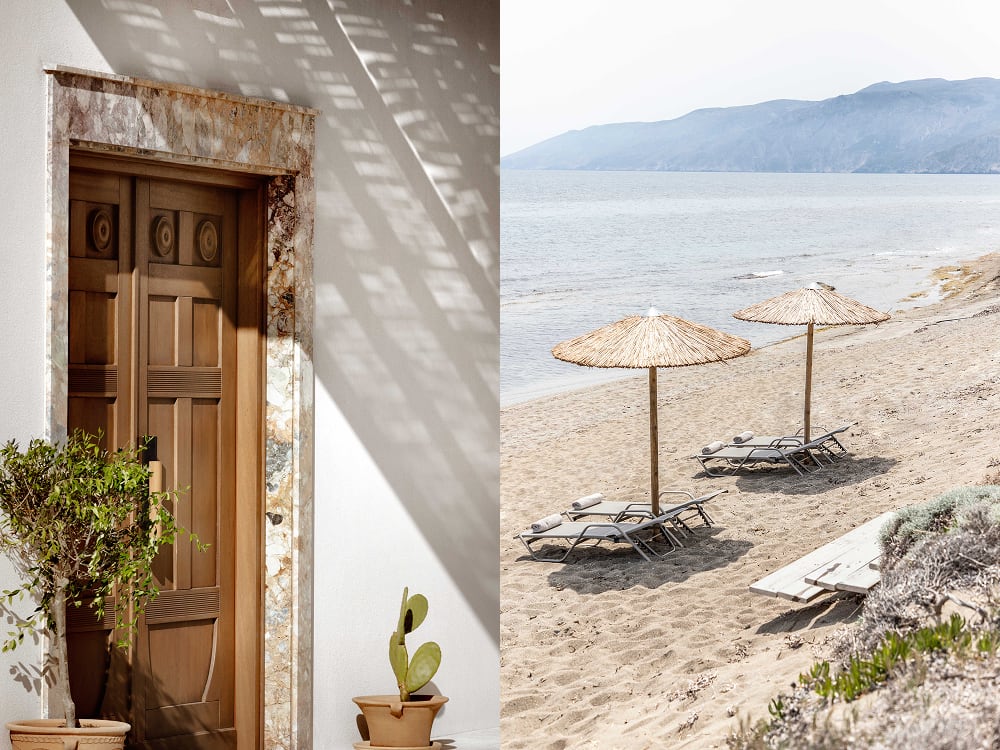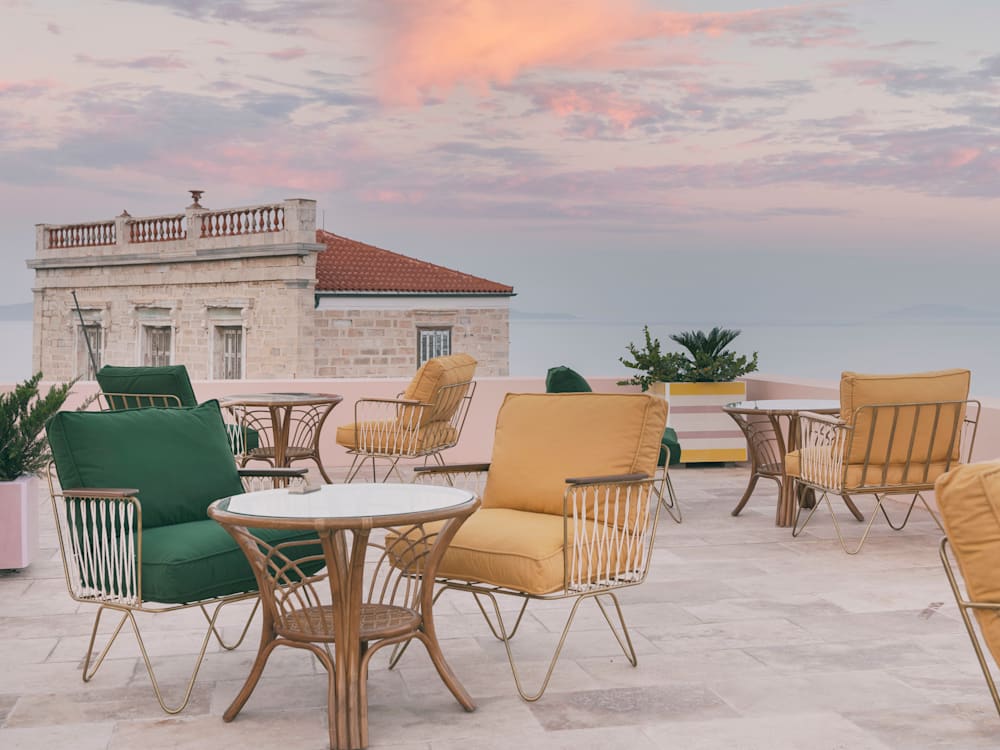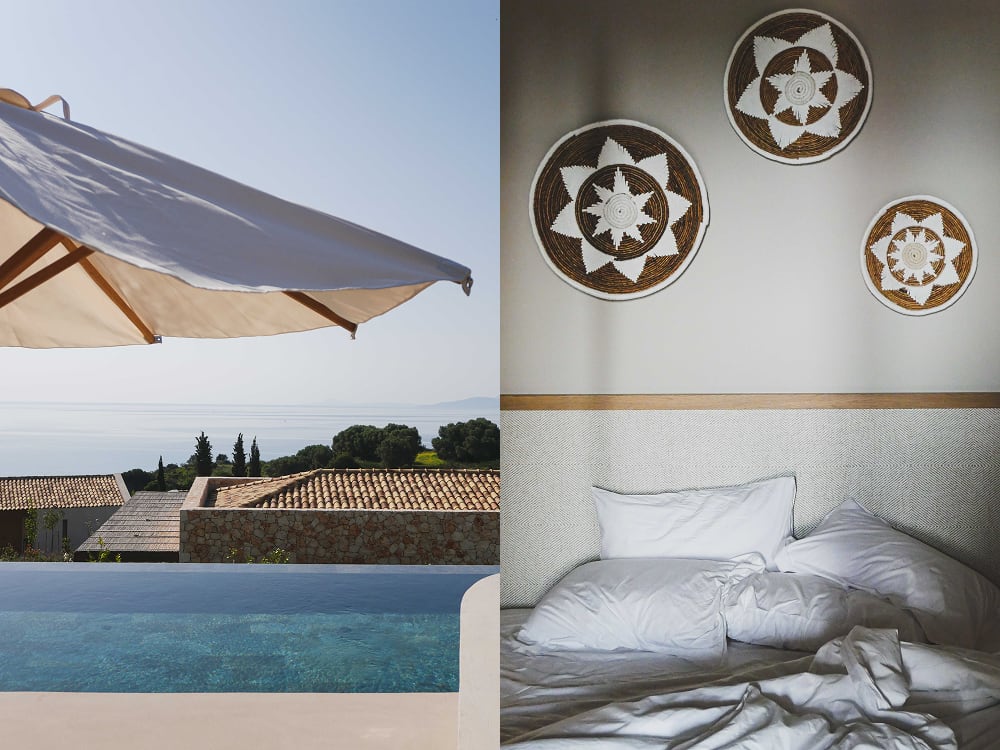Wherever you are in the Hellenic Republic, you’re never far from something ancient. Almost every destination has a link to myths and legends, which is great news for Classics fans. And many of the islands have a role to play in the great stories of Ancient Greece.
History buffs, antiquarians and those seeking a storied retreat, follow our winding yarns through the country’s islands and discover the best places to visit for Greek mythology in its motherland.
SKYROS

Aleró Seaside Skyros Resort
There’s no shame in admitting that most of us are probably only familiar with the Sporades archipelago thanks to two of its isles starring as the scene-stealing backdrop of the original Mamma Mia! film (Skopelos and Skiathos). How we all wanted to dance and sing our way up a hillside to a whitewashed church at the top, have breakfast beneath some bougainvillea and terrorise the locals with some karaoke. One of the Sporades’ lesser-visited isles is sleepy Skyros. To reach it, simply fly to Athens or Thessaloniki and connect on a swift flight (both under an hour).
The myth With the help of his protective mother Thetis, the (eventual) hero warrior Achilles delayed his conscription to the Trojan War, escaping to the isle Skyros, where he disguised himself as a girl named Pyrrha in the court of King Lycomedes. Odysseus and Diomedes soon came knocking and discovered Aristos Achaion — aka ‘the best of the Greeks’, no less — was hiding right here in the Sporades.
Where to stay Aleró is as dazzlingly all-white as you’d hope, with pool-enhanced, family-friendly suites and a beach on its doorstep. The kitchens are manned by the twice-Michelin-starred chef Angelos Lantos and the bar takes inspiration from the English poet Rupert Brooke. Brooke was buried on the island after he died on a vessel moored off its coast during the First World War; the cocktails are named after the titles and verses of his poems.
SERIFOS
Over in the Cyclades, which are so named because they fan out in a circle around Delos, a sacred mound in the middle of the Aegean, Serifos has remained a little less touristy than many of its counterparts. It’s slightly harder to reach, as all the best places are, but the odyssey (sorry) will be worth it. There’s no airport on the island, so you’ll have to arrive via boat from Athens (a journey of up to four-and-a-half hours) or a neighbouring island that has a runway.
The myth Take your pick: Serifos features in lots of them. Persecuted princess Danaë washed up here in a chest along with her future-hero son Perseus, after being banished by her father King Acrisius, who was acting in fear of a prophecy that his grandson would kill him (spoiler alert: he eventually does, with a poorly thrown discus). It’s where a shipwrecked Odysseus and his men encountered the Cyclops Polyphemus in a cave. And it’s where Perseus is thought to have first tried to defeat Medusa, later escaping triumphant with the gorgon’s head.
Where to stay Budget-friendly hotels and Greek islands don’t often go hand in hand, thanks to the super-yachts that now drop anchor every summer — but this is where Nostos Serifos comes in handy. This budget-boutique beauty, close to the shores of Livadakia Beach, has rooms starting from €90 in shoulder season.
SYROS

Aristide Hotel
If islands had personalities, Syros would be your highbrow academic — the capital of the Cyclades has its own university, a packed cultural calendar and sizeable year-round population. Unsurprisingly for somewhere so esteemed and erudite, it has a different look to many of its neighbouring islands, favouring colourful neoclassical mansions, Venetian architecture and glossy marble-paved streets over whitewash. The island has a domestic airport, reached via connecting flight from Athens. Boats dock at Hermoupolis in the east, but don’t miss the mountainous north for its vineyards and olive groves.
The myth Syros is said to be the birthplace of everyone’s favourite winged messenger (one that would never lob your parcel over your garden fence): mischievous and swift Olympian, Hermes. The island’s capital Hermoupolis is named after him (literally meaning ‘town of Hermes’). Another famous son of Syros is the philosopher Pherecydes, thought to have been Pythagoras’s teacher.
Where to stay Suitably aristocratic for Syros, the nine-suite Aristide Hotel is in a grand neoclassical mansion a short walk from the centre of Hermoupolis and its gleaming marble main square. The family-run retreat has been a labour of love for its owners, and it shows in the detail and dedication. Or check-in to Castro Hotel, built in the 18th century for its well-heeled Italian owner, closer to the centre of the port capital.
CRETE
Crete is huge, the Mediterranean’s fifth-largest island, so you’ll need to allow plenty of time to explore it fully, especially if you’re in search of arch deities and mythical beasts. There are gorgeous Venetian-relic towns such as Chania and Rethymno, happening harbours like Heraklion, archaeological sites and ancient monasteries, buzzy beach resorts like Agios Nikolaos and, yes, there is Malia, a strip best left to the 18–30 crowd.
The myth Primary-school fave the Minotaur has been capturing the imagination of children for centuries. The beast — or Asterion, to use first-name terms — was imprisoned in a labyrinth built by Daedalus within King Minos’s palace. He terrified the populace for decades, before he was eventually defeated by the hero Theseus with the help of Cretan princess and expert weaver Ariadne’s web-spinning skills. The island is also the birthplace of Zeus, king of the Olympians himself.
Where to stay Phāea Cretan Malia (pronounced, before you panic, ‘fire’) may be in party-centre Malia, but you won’t find any lurid cocktails served in watermelons here. Instead, you can expect naps in a hammock, strolls in the peaceful gardens and yoga practice in a pavilion.
ITHACA

Eliamos Kefalonia
The birthplace of Odysseus and a mirage seen during his long journey home, Ithaca is part of the Ionian Islands, along with Corfu and Kefalonia. It’s one of the smallest in the archipelago, with no airport and a population numbering less than 3,000. International flights touch down in Kefalonia and a short boat ride (under an hour) will bring you to Ithaca. Fewer tourists make it here, so you’ll have the secluded coves and immaculate shores to yourself.
The myth Ithaca is most famous for being where the Greek hero Odysseus was born. He spent years away from the island, encountering various beasts, enduring the wrath of various gods, being held captive by obsessive nymphs and longing for home — a yarn soon to be told in epic-movie form by Christopher Nolan.
Where to stay A swift sail away in lush Kefalonia, Eliamos has just 12 villas, each of which has its own saltwater pool. The largest, with three bedrooms, is perfect for families and groups. There’s a communal pool, too, overlooking the Ionian Sea.
MYKONOS
Mykonos has come a long way from its sleepy fishing-village days, thanks in no small part to the most glamorous denizens of the mid 20th century — Jackie O still has a beach club named after her here.
It’s now one of the most visited places in Greece, with an international airport delivering the party-seekers. From here, you can take a boat trip over to see the ancient ruins of uninhabited Delos, the birthplace of Apollo.
The myth In the beginning, there was Chaos. Then came personified planets Gaia (aka Earth) and Uranus, and then the Titans. A power struggle was soon involved, when the Olympians came along, many the progeny of Rhea and Cronos.
Once the Olympians were eventually installed on Mount Olympus, after the 10-year Titanomachy war, the Giants were the next threat to defeat — the Gigantomachy battle took place in Mykonos, with the help of Hercules. The island’s massive rocks are said to be the petrified corpses of the fallen Giants.
Where to stay Set a little away from the Mykonos Town action — and all the better for it — Cali is next to Kalafati Beach at the edge of a cove with a lengthy pool, which does its best to tempt you away from the sand. Or head to Numo, also near Kalafati in the island’s south-east, where the decor nods to Mykonos’s Sixties heyday.
Ready to start planning your voyage? Discover the lesser-known Greek destinations, or explore our full collection of hotels in Greece



